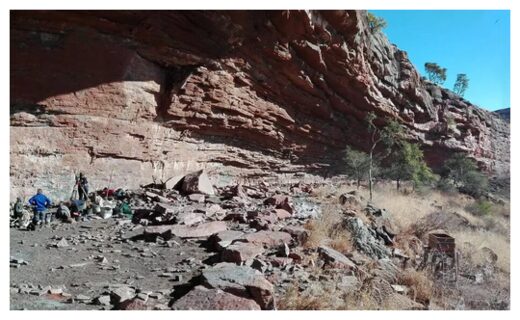The origins of modern humans and modern human cognition are thought to lie in southern Africa, as suggested by numerous archaeological findings from the southern tip of the continent. Many of these archaeological sites are located near the coast. This led to the widespread view that the evolution of complex symbolic and technological behaviour of Homo sapiens presupposing cognitive abilities very similar to ours today, were linked to the sea and it´s rich marine resources such as shellfish, fish and and marine mammals.
However, new archaeological findings in the Kalahari Desert in South Africa (the "African Outback") now shed new light on human prehistory and the evolution of modern human behaviour. The current archaeological thinking is that behavioural innovations in early human history are tied to coastal landscapes, and particularly to the south coast of South Africa that is particularly rich in natural resources and offered plenty of marine food year-round, hence served as an evolutionary hotspot for our species. And indeed, archaeological evidence for early behavioural innovations are clustering along South Africa´s coast line.
"In the present study we analysed findings from a rock shelter more than 600 kilometres inland and determined an age of 105,000 years for the archaeological layers and artefacts. They prove behavioural patterns equivalent to those found near the coast at the same time," explains Michael Meyer. The geologist is head of the OSL Laboratory at the Institute of Geology at the University of Innsbruck and was responsible for dating the sediment samples from the South African archaeological excavations together with Luke Gliganic, a former post-doctoral researcher at the University of Innsbruck. The results were published in the journal Nature.

Given the paucity of known stratified archaeological sites in the interior of Africa, the rich archaeological assemblage unearthed by this study can be regarded as a stroke of luck. "There have been very few well-preserved, datable archaeological sites in the interior of southern Africa that can tell us about Homo sapiens occupational and evolutionary history deep inside the continent rather than from the coast. The rock shelter on Ga-Mohana Hill, a visually striking rock formation that stands above an expansive savannah landscape in the Kalahari is one such site.
Our findings from this rock shelter show that overly simplified models for the origins of our species are no longer acceptable. Evidence suggests many regions across the African continent were involved, the Kalahari being just one," says the study's lead author, Jayne Wilkins from Griffith University in Australia. In the Kalahari Desert, the climate was wetter at the time of human presence and experienced a period of increased rainfall. The Ga-Mohana rock shelter was used as a spiritual site more than 100,000 years ago and continues to be used so today.
Hence, the excavation team was conscious to minimise their impact on the local indigenous communities and on the site and back-filled the excavation pit after each season. The team found 22 white calcite crystals and fragments of ostrich eggshells, which were used by early humans as water containers. "Our analysis indicate that the calcite crystals were not introduced into the deposits via natural processes, but were deliberately collected objects likely linked to spiritual beliefs and rituals of early Homo sapiens," adds the archaeologist.
Sand grain as miniaturized clocks
The chronology of the Ga-Mohana rock shelter was determined by the research team using Optically Stimulated Luminescence (OSL) dating. OSL dating is based on the measurement of light stored in grains of sand and is one of the most important dating techniques currently available in the earth sciences and in archaeology. "This method exploits natural light signals that accumulate through time in sedimentary quartz and feldspar grains.
You have to think about each grain as a miniaturized clock. Under controlled laboratory conditions we can read out this natural light or so-called luminescence signal, which in turn informs us about the age of the archaeological sediment layers. The more light the older the sediment," Michael Meyer describes the procedure. In the OSL laboratory at the University of Innsbruck, a broad range of geological and archaeological research questions have been investigated over the past years, with spatial research foci ranging from Africa to Australia, the Tibetan Plateau and the European Alps. The team in Innsbruck follows a particularly thorough dating approach: "We measure each sample on the single-grain level using dedicated laser equipment and statistical models to calculate sediment ages from hundreds of individual sedimentary quartz grains.
This approach is labour-intensive and time-consuming and requires a high degree of methodological skill, but pays off, because of the enhanced robustness of the resulting OSL chronology. And it allows us to make much more precise statements about human-environment dynamics and interlinkages than would otherwise be possible with conventional dating approaches," says the geologist. This was also the case at the Ga-Mohana rock shelter, where OSL single-grain dating matched perfectly with the age of independently dated climate archives, providing a much more detailed insight into human evolutionary history and concurrent climatic and environmental changes.




So the crow must be a very spiritual bird, and other very "spiritual" animals https://en.wikipedia.org/wiki/Hoarding_(animal_behavior), [Link]
Spoiler alert, .. It is called food hoarding